"No weapon in the arsenal of the Imperium or the Traitor equals the Titan on the battlefield, and a Legion of such vast war machines can bring any world to its knees. In truth, a Titan has only three enemies: folly, hubris, and another of its own kind."
- — Grand Master Volkus, Ordo Sinister of the Divisio Militaris

The Pax Macharia, an Imperator-class Titan
A Titan, sometimes colloquially called a "god-engine" or "god-machine," is any one of several classes of massive, crewed, robotic combat walkers fielded by the Titan Legions of the Adeptus Mechanicus' Collegia Titanica or by the forces of Chaos' Dark Mechanicum.
Originally, this term referred to many types of large combat walkers used by all of the different factions of the Milky Way Galaxy. Titans are always considered the largest and most powerful types of war engines available to the different factions of the galaxy.
Xenos Titans have now been renamed by Imperial scholars with the same titles for these war engines as the species that created them, such as the Aeldari Phantom or the Gargants of the Orks. The only robotic combat walkers considered to be "true" Titans at the present time are Imperial Titans and the Chaos Titans of the Dark Mechanicum.
Titans are the most sacred war machines of the Adeptus Mechanicus and they are thought by the Cult Mechanicus to be the greatest physical embodiments of the Machine God in the material universe, rightly called "god-machines" and "god-engines" by the Tech-priests.
Titans represent the real backbone of the Mechanicus' military might and are the heaviest ground units that can be deployed by the Imperium of Man's armed forces. Every Forge World of the Adeptus Mechanicus is protected by armed forces that include the Skitarii, Praetorian Servitors, and one or more of the Titan Legions of the Collegia Titanica.
The true scale of the largest Titans can be difficult to visualise. In the Winter Assault expansion to the computer game Warhammer 40,000: Dawn of War, an ancient, fallen Imperator-class Titan, the largest type of Battle Titan, can be seen. Its prone and half-buried wreckage stretches across an entire battlefield, and the barrel assembly of its right arm-cannon alone is over 30 metres in diameter.
Quick Answers

What is the significance of a Titan in the Warhammer universe?

What are the three enemies of a Titan according to Grand Master Volkus?

Why is a Titan sometimes referred to as a 'god-engine' or 'god-machine'?

What is the difference between a Warlord Titan and an Emperor Class Titan?

How does the size of a 40k Titan compare to other war machines in the Warhammer universe?

God-engines of the Mechanicus
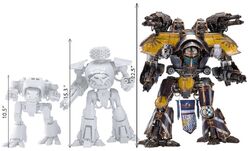
An official Collegia Titanica Scout and Battle Titan size comparison chart (left-to-right); A Warhound-class Scout Titan, a Reaver-class Battle Titan and a Warlord-class Battle Titan
The first Titans were built during the Age of Strife on Mars, as a way for the newborn religion of the Cult Mechanicus and its Mechanicum government (the ancient, pre-Horus Heresy predecessor of the Adeptus Mechanicus) to effectively fight its enemies in the raging wars to reclaim the Red Planet's irradiated surface from feral mutants and insane thinking machines. After Mars had been secured by the Tech-priests, the Titans later accompanied the early Mechanicum colonial fleets sent blindly through the Warp from Mars that established the first Forge Worlds, leading to the creation of the Titan Legions -- armed forces made up entirely of Titans specific to that Forge World.
Most Titans stand between 15 and 60 metres (about 50 to 196 feet) tall, though the extremely powerful and very rare Emperor Titans can stand up to 150 metres (492 feet) in height. There are a variety of different classes that a Titan can belong to, but all Titan Legions ultimately serve the division of the Adeptus Mechanicus called the Collegia Titanica.
Most Titan classes belong to one of three separate physical grades arranged by size and combat strength -- Scout Titans, Battle Titans and the largest and most powerful, the Emperor Titans. Scout Titans include many smaller, more mobile classes of the great war engines which are used for reconnaissance and infantry fire support missions by most Titan Legions. The Battle Titans are the most commonly deployed classes of Titan and provide the backbone of any Titan Legion's strength. The rare Emperor Titans are the true kings of the battlefield in the Warhammer 40,000 universe, and the two classes of these Titans are used to provide a Titan Legion's primary offensive and defensive power.
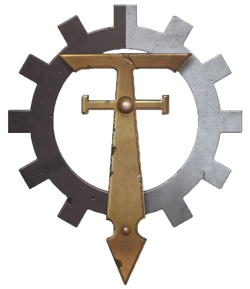
Icon of the Collegia Titanica, also called the Adeptus Titanicus.
Due to their importance and high standing in the Imperium as a result of the advanced technology used in their creation, all Titans are important enough to be given their own High Gothic names when built. This is represented by giving each a two-word High Gothic name, always some venerated title or concept, usually from the creed of the Imperial Cult.
Examples include Aquila Ignis, Regalis Annihilatus, Vitas Falco, Imperius Eradicus, Imperius Belladon, Apocalyptus Credo, Imperius Brontos, Imperius Excelsior, Dies Irae, Octimus Ligus, Imperius Augusta and Imperius Dominatus. Similarly, the loss of a Titan is considered tragic and mourned openly by the Forge World that produced it.
Imperial Titans are unique in the sense that their computer mind-cores or "Machine Spirits" in the lexicon of the Mechanicus are sentient and even self-aware, albeit in a highly-erratic manner. This is in contrast with the usually non-sentient "Machine Spirits" or onboard computer systems found in many other Imperial war machines like tanks and armored vehicles.
In the "Titan" comic, the newly connected princeps was formally greeted by the Titan Imperius Dictatio inside its mental landscape; there was also the Titan Laudator Magnificat, which was forcibly reactivated after falling in combat. This proved disastrous: the god-engine's mind-core had suffered severe psychological trauma from its "death," and began attacking everything in sight in its mindless rage.

Titans clash during the Horus Heresy.
Most Imperial Titans are roughly humanoid in shape, but with thick lower legs, a hunched head, and an oversized torso. Forward-oriented main weapons mount directly into where the arms would be, and additional weapons are often found on the chassis. These configurations (called "patterns") vary, and most Titans are built on these precepts.
However the actual design of the chassis can vary greatly, so only the absolutely basic features (such as leg joints and weapon hardpoints) are constant. This is most evident in the Warhound-class Titans (the Lucius Pattern looks more geometric and broader than the Mars Pattern, the form of which is more rounded and animalistic).
Imperial Titan Classes
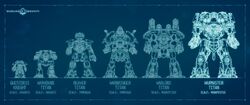
Size comparison chart of Imperial Titans, including the Warmaster, which is 40.91 metres tall (approx. 134 feet).
Rapier Scout Titans
The Rapier-class Titan is an Imperial Titan that was most commonly used during the Great Crusade and Horus Heresy. It is a Scout Titan, and is the smallest known class of Imperial or Chaos Titan, being even lighter armed and swifter than a Warhound-class Scout Titan.
During the final years of the Horus Heresy, it was noted that the Rapier was becoming an ever rarer sight among the orders of battle of the Titan Legions of both Traitors and Loyalists.
Warhound Scout Titans
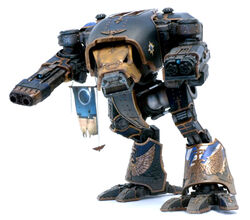
Imperial Warhound-class Scout Titan
Warhound-class Titans are the scouts or flanking elements of a Titan Legion and are the most common form of what are called Scout Titans by the Collegia Titanica.
Appearance-wise, the Warhound differs structurally the most from other Imperial Titans; it possesses an anthropomorphized, canine-like shape, reverse-jointed legs and shoulder weapon mounts. Warhounds are lightly-armed and armoured compared to other Titans, although still fearsome when facing the standard armoured combat vehicles deployed by the other intelligent species of the galaxy.
They are the only Titans to be normally deployed by the Titan Legions in packs of two members, as compared to the larger Battle and Emperor Titans which usually operate alone. The Warhound Titans can only operate in a maximum of two as a result of the actions of Chaos Warhound Titans during the Horus Heresy. When the Traitor Titan Legions landed on the Throneworld at the end of the Horus Heresy during the Siege of Terra, Horus let them terrorise Terran civilians in squad-sized (10+) units of Warhounds.
As a result of this blood-stained history, the Adeptus Terra during the reformation of the Imperium in the Time of Rebirth after the Horus Heresy ordered the Titan Legions to never allow Warhound Titans to operate in squads larger than two Titans to prevent such horrors from being perpetrated upon Humanity again.
Available in several different patterns produced by the various Forge Worlds with different weapon loadouts, Warhound Scout Titans stand 17.08 metres (approx. 56 feet) tall. On the battlefield, the Warhound has been proven to be very effective, as its double-barrelled Turbo Laser can destroy super-heavy armoured vehicle enemies with ease.
Dire Wolf Heavy Scout Titans
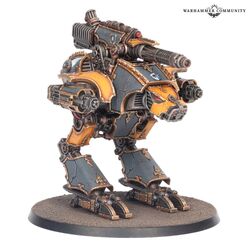
A Dire Wolf-class Heavy Scout Titan armed with arm-mounted Ardex Defensor Mega-Bolters and its carapace-mounted Neutron Laser.
The Dire Wolf-class Titan is considered a "Heavy Scout Titan" which places it in size between the Warhound-class Scout Titan and the smallest of the true Battle Titans, the Reaver-class Titan. It was deployed by the Loyalist and Traitor Titan Legions during the Great Crusade and Horus Heresy.
Dire Wolf Heavy Scout Titans were much sturdier and more heavily armoured than their Warhound Scout Titan counterparts. The Dire Wolf was easily distinguished from the Warhound by its reinforced frame and unorthodox arm weapons. The Dire Wolf carried its massive main weapon on the back of its torso, sacrificing some mobility for added stability to handle the recoil and weight of this payload. Hunched forward, the Titan's heavy armour plating and stout legs provided stability and durability.
The Dire Wolf was armed with unusual, pintle-mounted weapons on its arms in the form of Ardex-Defensor Mega-Bolters, which offered some defence against enemy Knights, allowing the Dire Wolf to focus on lining up a firing solution with its main carapace-mounted Neutron Laser weapons. Neutron Lasers required a massive amount of power, and generated incredible heat, requiring sophisticated additional modifications to the carapace and chassis of the Dire Wolf.
Some Dire Wolf Titans were armed instead with a carapace-mounted Volcano Cannon -- a weapon so massive and powerful that it is usually only found on Reaver-class Titans. Additional cooling and structural modifications to the carapace and chassis of the Dire Wolf were required to accommodate such a large weapon.
Reaver Battle Titans

Mars Pattern Reaver-class Battle Titan Invigila Alpha of the Legio Astorum, the "Warp Runners"
The Reaver-class Titan is a medium-sized Titan and the smallest of the classes of Battle Titans. They are considerably more durable than Warhounds, and are able to take roughly twice as much damage before succumbing. This extra durability is probably a result of the unusual placement of the Titan's plasma generator on the back of the main carapace, whereas in most Titans the generator is located at the core, hence the term "power core."
This placement ensures that the Reaver Titan can take more frontal damage than other Titans of the same approximate class, but is at a severe disadvantage when in cluttered environments (cities or canyons).
A Reaver Titan stands 25.21 metres (approximately 83 feet) in height. The Reaver is also described as an older design of Titan than the Warlord. The weapons mounted are variable; they can mount some of the more powerful Battle Titan weapons, although Scout Titan weapons are more common. Most of the patterns of the Reaver carry Titan-grade Multiple Rocket Launchers on their carapace mounting.
Unlike Warhounds, Reaver-class Titans can use close-combat weapons, which are extremely effective in Titan-scale mêlée battles. However, it is suggested that Reavers are becoming increasingly rare in Imperial armies, and it is possible that the technological secrets to their manufacture have been lost to the Adeptus Mechanicus' Forge Worlds (a common fate for the more advanced Imperial technologies). For these reasons, Reaver-class Titans usually perform fire support roles, avoiding direct combat.
The Mars Pattern Reaver-class Titan's carapace mounts a Multiple Rocket Launcher and Turbo-Laser Destructors on each arm. The Lucius Pattern's carapace bears a Rocket Launcher, with the arms carrying a Volcano Cannon and Gatling Blaster. There is also a fire support variant of the Lucius, with Multiple Rocket Launchers on all three mounts.
In the past, Reaver Titans were sometimes given different sub-class names to distinguish their weapons load-out; these were the "Goth" (fire-support Titan), the "Vandal" (inspirational/morale-boosting Titan) and the "Hun" (a tactically flexible weapons loadout).
Komodo Battle Titans
The Komodo-class Titan was a type of Battle Titan deployed by the Collegia Titanica during the Great Crusade and Horus Heresy.
Punisher-class Titan
The Punisher-class Titan was a rare class of Imperial Titan that possessed three legs. A Punisher-class Titan, the Modus Destructor, was deployed to Ullanor Prime during the War of the Beast in the mid-32nd Millennium to defend the Adeptus Mechanicus command centre established on that world during the Imperial invasions. The Modus Destructor was armed with two Tezlan Accelerators and two underslung Plasma Annihilators.
Executor Battle Titans
The Executor-class Titan is a Battle Titan of the Collegia Titanica. It was part of the first Imperial strike force deployed to defeat the Orks on the world of Ullanor during the War of the Beast in the mid-32nd Millennium.
Apocalypse Battle Titans
The Apocalypse-class Titan is a rare type of Battle Titan of the Collegia Titanica that was deployed during the Great Crusade and Horus Heresy. It was noted to have fought during the battles of the Thramas Crusade with the Legio Victorum I.
Carnivore Battle Titans
The Carnivore-class Titan was a rare class of Battle Titan employed by both the Traitor and Loyalist Titan Legions during the Great Crusade and Horus Heresy. It saw heavy action in the Battle of Beta-Garmon, also known as the "Titandeath," during the Heresy.
The Carnivore-class Titan stood in size somewhere between a Reaver-class Titan and a Nightgaunt-class Titan.
Mirage Battle Titans
The Mirage-class Titan is a Battle Titan of the Collegia Titanica that was comparable in size and firepower to a Carnivore-class Titan or a Warlord-class Titan. It was deployed during the Great Crusade and Horus Heresy.
Warbringer Nemesis Battle Titans
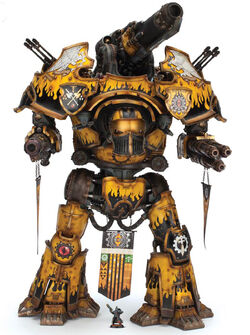
A Warbringer Nemesis-class Titan of the traitorous Legio Fureans.
The Warbringer Nemesis-class Titan is a Battle Titan that stands between the Reaver and Warlord-class Titans in size and power. It is used by the various Titan Legions of the Collegia Titanica and the Chaos Titans of the Dark Mechanicum.
Like a god of destruction, the Warbringer Nemesis rains explosive death on its foes. This immense war machine is designed to obliterate the largest and most indomitable enemies at extreme range.
The Quake Cannon mounted on its back is capable of demolishing fortresses or even felling other Titans with a single, gargantuan shell. Similarly, the Titan's myriad other armaments allow it to wreak ruin on aircraft, armoured columns and massed infantry formations.
Warbringer Nemesis Titans are renowned for their bellicose Machine Spirits (artificial intelligences), with numerous binharic canticles speaking of the Titans locking onto targets and assuming firing positions before their Tech-adept crews are even aware of the approaching threat.
Warlord Battle Titans
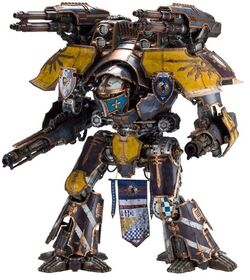
A Mars Alpha Pattern, Warlord-class Titan of the Legio Gryphonicus
Warlord-class Titans are a larger and more powerful type of Battle Titan than its counterpart, the smaller Reaver-class. They appear to be the most common class of Battle Titan in use by the Titan Legions, and many Forge Worlds field their own patterns. The Warlord is much larger than the aging Reaver-class Titan, putting its height at 32.76 metres (approximately 108 feet). The Warlord Titan is also able to withstand a great deal more damage than the Reaver. However, there is considerable conflict in the Imperial records concerning this matter.
A Warlord Titan was also listed as approximately 33 metres (110 feet) tall according to the scale diagram in the Warhammer 40,000: Apocalypse rulebook. Other accounts have stated it to be as large as 200 metres (656 feet). Depictions of the Warlord in Imperial artwork are even less consistent, sometimes showing it to be hundreds of metres tall.
The Warlord Titan is also able to withstand considerably more damage than the Reaver as they are encased in layered armour and powerful void shielding, and armed with weapons that are capable of reducing armies to ash.
The Warlord-class Titan has four Battle Titan weaponry hardpoints on the shoulders and arms, allowing for a greater variety of weapon configurations. While Scout Titan weapon batteries can be mounted, Warlords usually mount Battle Titan-grade weaponry.
There is even a specialist class based on the Warlord design, the rare Psi-Titans, where psychic weaponry is added for use against Daemonic entities. Warlord-class Titans can also be organised into mixed battle groups with Reaver-class Titans (3 of each class of Titan).
These battle groups can be armed and used as the group's commanding senior princeps sees fit, but they work together to complete a common objective. In general, the princeps of the more powerful or oldest Titan in a group is the commander of the battle group.
The colossal Mars-Alpha Pattern Warlord Titan is among the most ancient and feared of the Imperium's war machines. Forged on the Red Planet itself, it is worshipped and venerated as the Omnissiah's will incarnate, and each god-engine is encased in layered armour and powerful void shielding, and armed with weapons that are capable of reducing armies to ash.
In addition to its Ardex-Defensor Mauler Bolt Cannon and Lascannon turrets, support weapons that would be considered main armaments on smaller war machines, the Mars-Alpha Pattern Warlord is commonly fitted with a pair of carapace-mounted triple-barrelled Laser Blasters and two Belicosa Pattern Volcano Cannons.
Game History
The Warlord Titans were the first to be introduced in the Epic scale, featured as a box set with 6 plastic models and Styrofoam buildings. The accompanying rules were meant for Heresy-era Titan versus Titan combat. Simple rules for interactions with vehicles and infantry were subsequently published, and the Epic Space Marine box set developed the full initial rules for infantry and vehicles.
Rules for normal Warhammer 40,000-scale Warlord-class Titans were introduced in the 2007 Warhammer 40,000 supplement, Apocalypse; however no model to represent it on the field has been produced by Games Workshop or its subsidiaries thus far, encouraging players to build their own from scratch should they wish to field such a weapon in their army.
The expansion Apocalypse presented rules for the Warlord Titan. It can equip with all Warhound-class Titan weapons and has access to a variety of anti-infantry and destroyer weapons, including the Vortex Missile. However, it cannot engage close targets effectively.
There is currently no model for the Warhammer 40,000 range, requiring scratch construction for the modeller. If one is to construct a Warlord, it should be approximately two feet tall to be of the proper scale alongside the other models.
According to the out-of-print Adeptus Titanicus game, Warlord-class Titans are sometimes differentiated according to their weaponry. A Nightgaunt Warlord has two or more assault weapons, a Deathbringer Warlord has a 'tactical' (i.e. flexible) weapon fit, a Nemesis Warlord has two or more support weapons, while an Eclipse Warlord will have given some weapon hardpoints over to inspiring religious relics of the Imperial Cult such as the Devotional Bell.
Warmaster Heavy Battle Titans
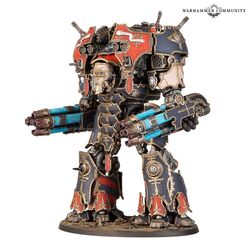
A Warmaster-class Heavy Battle Titan armed with twin Suzerain-class Plasma Destructors and a carapace-mounted Revelator Missile Launcher.
The Warmaster-class Titan is what the Adeptus Mechanicus classifies as a "Heavy Battle Titan," which makes it amongst the most powerful classes of Titans in the Imperium of Man.
Looming over even a Warlord-class Battle Titan at approximately 40.91 metres (134 feet) in height, the Warmaster is equipped with a pair of Suzerain-class Plasma Destructors that turn anything they hit into molten slag, a Titan-sized Revelator Missile Launcher and a pair of Turbo-Laser Destructors (or similarly destructive weapons) mounted under the carapace.
For protection the Warmaster is equipped with seven Void Shield generators. Six servitor clades also mean that repairing damage is easier for the Heavy Battle Titan's commanding princeps.

Size comparison chart of Imperial Titans, including the Warmaster, which is nearly 41 metres tall (134 feet).
It took a conflict on the scale of the Horus Heresy -- a war that resulted in the nascent Imperium being torn apart and the Space Marine Legions turning against one another -- for the ancient Mechanicum to unleash the Warmaster-class Heavy Battle Titan.
With the virtue of hindsight, it is perhaps unsurprising that the Mechanicum kept knowledge of this mighty god-engine from the rest of Mankind, for ever was the Cult Mechanicus built upon a foundation of secrets. Yet the Warmaster Titan was not a tool of political power nor a pillar of strength but a weapon of apocalyptic death and destruction, shrouded and slumbering until a Mechanicum Forge World stood at the precipice of extinction.
On that day, the Warmaster Titan would stride to war, leaving naught but blood and ash in its wake. Its existence was a protected secret within the highest echelons of the Mechanicum, and it was never spoken of openly to peers nor outsiders.
Warmaster Iconoclast Heavy Battle Titans
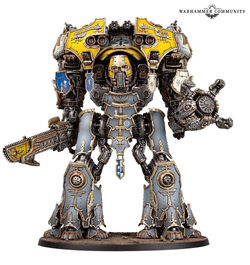
A Warmaster Iconoclast-class Heavy Battle Titan armed with Desolator Chainsword, Krius Siege Drill, Cruciator Gatling Array and Vulcan Mega Bolters.
A Warmaster Iconoclast Heavy Battle Titan is a variant of the Warmaster Titan that has been redesigned to take the lead in close-quarters melee combat and the destruction of static fortifications and defensive emplacements.
When reports of the Warmaster Iconoclast variant first emerged during the Horus Heresy, many on both sides of the civil war presumed it simply a retrofit of the standard Warmaster-class Titan. Indeed, in appearance the two Titans are similar, based as they are upon the same chassis and possessed of similar defensive and offensive capabilities. Yet, it is the beating heart of the Iconoclast that sets it apart, for within each one dwells a Machine Spirit of noticeable ferocity, its lust for war and bellicose demeanour far more akin to that of a frenzied animal than that of the anima housed within other god-engines.
When awakened, the Machine Spirit of a Warmaster Iconoclast-class Titan desires nothing more than to march into the thickest fighting, lay waste to the edifices of its foe, and slake its anger on any who would defy it. The sheer potency of the Warmaster Iconoclast ensures only the most self-assured of princeps have the strength of will necessary to tame the beast within it.
In battle, the Warmaster Iconoclast serves as the Omnissiah's vanguard, often the first god-engine to march when the enemy cowers within seemingly impenetrable strongholds. While the apocalyptic might of each god-engine can lay waste to swathes of enemy territory, the Warmaster Iconoclast is specifically equipped to face fortresses prepared for more conventional methods of siege warfare. Layers of void shields surrounding a fortification offer little protection, for the god-engine simply strides into the teeth of the enemy guns and through the shields.
It is in close-quarters warfare that the Warmaster Iconoclast truly excels, for face to face with the enemy is where it can unleash its barely-restrained wrath, raking entrenched foes with Flamers, Melta Cannon and sustained gatling bursts. What little remains is brought low by close-quarters weapons specifically engineered for the Warmaster Iconoclast, its Krius Siege Drill tearing through thickened armour plating with ease and wide sweeps of its Desolator Chainsword eradicating entire squadrons of armoured vehicles. Once all within reach have fallen, the Iconoclast marches forth once more, never to rest until only the true servants of the Omnissiah remain.
The Warmaster Iconoclast is a god-engine designed with singular purpose, a tool created for nothing short of obliteration. Even its plasma reactors feature modifications intended for engaging the foe up close, with dedicated void shunts designed to weather the fiercest firepower and kinetic transducers that utilise the Titan's movement to empower its weapons. Those few who know of the Warmaster Iconoclast-class' existence fear its arrival upon the battlefield, for the march of such a god-engine renders the impenetrable into little more than an inconvenience.
Emperor Titans
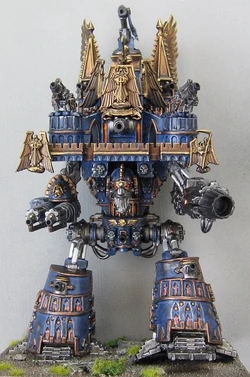
The super-heavy Battle Titans called Emperor Titans are subdivided into two known classes, the Imperator-class Titan and Warmonger-class Titan.
Of these, the Imperator-class Emperor Titan is a general-purpose assault platform, whereas the Warmonger-class Emperor Titan is a dedicated, long-range fire-support unit with advanced fire control and targeting systems.
Both are extremely powerful weapon systems and are often unmatched by an enemy force on any battlefield where they are deployed. They are loaded to the brim with pre-installed weapons, and their mounts can handle Titan weapons too big for even other Battle Titans (they do not carry any of the close-combat weapons, as their sole focus is on extreme firepower).
Emperor Titans are very rare, and can crush many weaker war engines. This type of Titan has legs so large they can house a full company of Adeptus Mechanicus or Astra Militarum troops for defence and assault assistance. These Titans can stand up to 150 metres (approximately 492 feet) tall.
More than a war machine, these tremendous Titans are also icons of worship to the Imperial Cult Mechanicus, as they are seen as an avatar of the Omnissiah; the most noteworthy feature of an Emperor Titan is the fortified castle structure that occupies its entire upper half. These cathedrals possess ornate features like spired towers and stained glass windows.
The "building" is heavily armed, and more than capable of contributing to combat. Due to the structure's prominent position on the Titan's back and shoulders, the Titan's head is hunched more than usual on the otherwise humanoid body, almost level with the arm weaponry.
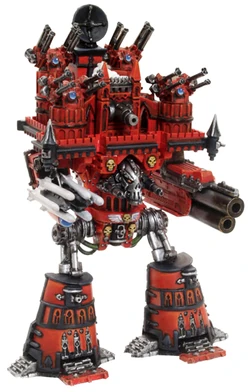
In Winter Assault, the planet Lorn V houses the fallen Mars Pattern Imperator-class Emperor Titan Dominatus. The size of the Imperator-class Titan is driven home by the fact that in the last mission, most of the map is dominated by the half-buried fallen Titan, laying on its back, with exposed parts protruding through the earth like massive buildings. Once the Titan is partially repaired and powered up, even the guns studding its joints, labelled as "minor hull defence weapons" are able to destroy heavy vehicles in just a handful of shots.
During the Dark Crusade, the planet Kronus was discovered to be home to the right arm and Hellstorm Cannon of the Imperator-class Emperor Titan Aquila Ignis, dismembered in a titanic battle during the Horus Heresy ten millennia prior. The Hellstorm Cannon was so large that its firepower carved a huge trench in front of where it lay.
In the game, the fallen cannon's capacitors can be slowly charged by an entire array of powerful thermoplasma generator buildings. When fired, any units that are caught in the trench that mark its firing path are instantly destroyed. No unit in the game is durable enough to survive even a single blast.
Castigator-class Standard Template Construct Titan
Discovered upon the lost Forge World of Chaeronia, the artificially intelligent Castigator-class Titan was a completely autonomous bipedal weapons platform, the first and only one of its kind ever built. Called the "Father of Titans," the Castigator claimed to be the "original" Titan, as it was first designed during the Dark Age of Technology, and that all subsequent Titan designs were but crude, and incomplete copies of it.
It was originally lost on the Forge World of Chaeronia during the Age of Technology and remained lost even when the planet was pulled into the Warp thousands of standard years later. During its time in the Warp, the Titan's artificial general intelligence made a pact with the Black Legion that had established an outpost on Chaeronia: by allowing a Daemon to possess it, it would be empowered by the Warp. The Castigator and Chaeronia remained in the Warp for a Terran millennia and its artificial intelligence forgot much of what happened during that time, including being possessed. The Castigator was discovered by the Imperium when the planet reemerged from the Warp by a force of Grey Knights led by Justicar Alaric and his battle-brothers.
The only known Castigator-class Titan was ultimately destroyed by these Grey Knights. When Alaric confronted the Castigator, its artificial intelligence did not believe it was possessed by a Daemon until Alaric convinced it of the truth, at which point the Titan's possessing Daemon appeared and it was slain by Alaric. Alaric then destroyed the Castigator while his battle-brothers Dvorn and Haulvarn destroyed the Titan's STC database to prevent either from falling into the hands of nearby Chaos forces. However, fragments of data from the Titan's STC were collected by the Adeptus Mechanicus for archiving and study.
The Castigator's design was stored in a Standard Template Construct database also present on Chaeronia. As a result of its ancient provenance, the Castigator made use of highly-advanced, long-lost technologies such as rapid self-repair routines and a synthetic, muscle-like locomotive system.
Standing larger than even the Imperator-class Emperor Titans, the head of the Castigator notably did not jut from its chest as on most Imperial Titan patterns but actually was above the shoulders, matched by an elegant yet super-heavy and very well-armoured chassis and impossibly-graceful movement. It was indeed far superior to any class of Titan utilised by the Adeptus Mechanicus or any other intelligent starfaring species in the galaxy. It was also the only known Titan controlled autonomously by an artificial general intelligence rather than a Human princeps and other crew and the only known Titan to have been made by an STC.
Its weapons included an arm-mounted melee weapon and a super-heavy, multi-barrelled cannon that fired Daemons. The ability to fire Daemons was later found to be due to the pact the Castigator's artificial general intelligence had formed with the Chaos Gods through the Black Legion.
Imperial Knights
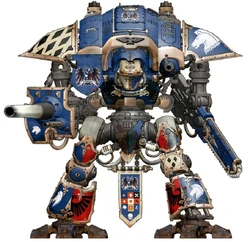
Knight Paladin, Scythe of Light, of House Terryn
Thousands of standard years before the rise of the Imperium, Mankind reached out to the stars and settled many far away worlds. Among the apparatus of colonisation were formidable war machines known as Knights, which existed to protect the early Human settlers from any threat.
The strongholds constructed from the remains of ancient Terran Long March colony starships are ruled by the descendants of the first Human settlers of those far-flung worlds, mighty fighters who go to war in their towering armoured battlesuits and who are sworn to protect and guard the Imperial citizens who inhabit their worlds.
These proud and haughty warriors can trace their bloodlines back to Terra itself and are colloquially known as "Nobles" in Imperial society and as the Questor Imperialis in formal High Gothic. Over the millennia, the pilots of these massive war suits have established a rich culture, aristocratic Knight houses each sworn to the defence of their homeworld, bound by oaths of fealty to the Golden Throne of Terra or the Adeptus Mechanicus of Mars.
Knights are small combat walkers that are a one-man version of a Titan. However, a Knight is smaller and less capable in combat than even the smallest class of true Titan utilised by the Titan Legions, the Warhound-class Scout Titan. Knights normally deploy in squadrons comprised of several of these war machines. These ancient battlesuits stand thirty to forty Terran feet tall, are protected by nearly impenetrable Ion Shields and armed with a devastating array of heavy weapons.
Imperial Knights are colossal war machines that tower over the battlefield. They are propelled into battle by powerful servos and have the power to kick over tanks and crush soldiers into red paste. Vulnerable limbs and joints are protected by sweeping armour plates of adamantium and supported by an incorporated Ion Shield which responds to the thought-commands of its Noble pilot. The presence of just one of these towering engines of destruction is enough to change the course of a battle, and only the Titans of the Collegia Titanica are more feared by the enemies of Mankind.
Titan Armament
The weaponry carried by Titans is usually dedicated to certain tasks based on the tactical and strategic conditions. Some weapons are designed for targeting high-priority and well-armoured enemies, such as fortresses or armoured divisions, whilst others are particularly effective against legions of troops or laying down devastating artillery barrages. Titan weapons are divided into two rough categories:
Scout Titan Weaponry
Scout Titan weapons are weapons normally fitted to light Titans such as the Warhound. Rarely found on the largest Titans, and usually of short range, these Titan-grade weapons are designed to destroy light to medium armoured vehicles quickly, and to deal with huge masses of infantry. Below are some examples of such weapons:
- Inferno Cannon - An upgraded version of the flamers mounted on vehicles, the triple-barrel Inferno Cannon is immensely devastating in close quarters against infantry and light vehicles, even those hiding in cover.
- Plasma Blastgun - The lightest plasma-based Titan weapon, and one of the most powerful that can be mounted on the Warhound Scout Titan. Although it possesses a relatively slow rate of fire, and is of only medium range, the Plasma Blastgun can badly damage well-armoured vehicles, other Scout Titans, and devastate infantry squads by the means of having two different modes of operation, depending upon the nature of the target: a slower, more focused full-power blast, or more rapid but less powerful shots.
- Turbo-Laser Destructor - The Turbo-Laser Destructor is a Titan-grade laser weapon, mainly used for anti-tank/anti-Titan support. It is very destructive compared to most vehicle and infantry-level laser weapons. More powerful than the Plasma Blastgun, as well as having a moderately longer range, this weapon is well-suited for sublimating small or heavily armoured infantry units just as easily as it can pierce the thick, iron hides of all types of armoured tanks. It is also the only Destroyer weapon that a Scout Titan can carry. Although it can be fitted on a Scout Titan, the Turbo-Laser Destructor is more commonly found on the larger Battle Titans, who are much better prepared to deal with the constant threat of armoured vehicles.
- Vulcan Mega Bolter - The Vulcan Mega Bolter is a Titan-scale bolter weapon, comprised of two large-calibre Gatling gun-style bolter assemblies. Projecting a withering volley of firepower, it is able to tear through infantry and light vehicles with ease.
Battle Titan Weaponry
Battle Titan weapons have more destructive and longer-ranged weapons mounted commonly on Reaver and Warlord Titans. Most are designed to destroy other Titans, engage enemy armour detachments, or bring devastation to fortifications:
- Blood Cannon - The Blood Cannon is a fell weapon utilised by Chaos Battle Titans dedicated to the Blood God Khorne. It fires lava-like Daemon blood which flows over and around cover, and through chinks in an opponent's armour, melting circuitry, vital components and anything alive.
- Titan Close Combat Weapons - This designation encompasses an entire category of gigantic melee weapons that employ a Titan's prodigious strength and size to smash and tear apart the enemy. They are horrendously effective against enemy Titans and war engines -- if the Titan can get close enough to use them. They can only be mounted on the Titan's arms; this rules out the Warhound Scout Titan making use of them due to its lack of arms. In Epic 40,000, close combat weapons include the Powerfist, Laser Burner and Chainfist.
- Gatling Blaster - The Gatling Blaster is a larger projectile weapon commonly found on Battle Titans. It is a rapid-fire weapon like the Vulcan Mega-Bolter, but instead fires 150 mm shells, powerful enough to inflict damage upon superheavily-armoured targets.
- Hellstorm Cannon - The Hellstorm Cannon is a huge, five-barrelled, directed-energy weapon that can completely decimate an entire city (perhaps even more) in just one cataclysmic salvo. In addition, the central structural hub around which the weapon barrels are mounted can itself be converted to mount a Gatling Blaster. A Hellstorm Cannon, detached from a long-destroyed Emperor Titan, can be seen lying on its side in near the city of Ironworks Bay (or Victory Bay, as it was later named by Lord-Militant Lukas Alexander) on the planet Kronus during the Dark Crusade. A trench large enough to move an armoured company through has been carved out of the earth in front of the cannon from its final firing.
- Melta Cannon - The Melta Cannon is an upsized Melta Weapon mounted on Warlord Titans. Notably short-ranged, but incredibly effective at penetrating armour and destroying Titans.
- Multiple Rocket Launcher - The Multiple Rocket Launcher is a long-range rocket artillery weapon which unleashes heavy barrages to suppress and devastate enemies. Because it is mounted on a Titan, it is much less vulnerable to air assaults and fast armoured attacks than dedicated artillery companies.
- Quake Cannon - The Quake Cannon is a very, very large artillery piece that is larger and more powerful than any other artillery weapon ever developed by the Imperium.
- Volcano Cannon - The Volcano Cannon is a great Plasma Weapon powered directly from the Titan's plasma reactor. The Volcano Cannon has extreme range and is very effective at penetrating armour, making it useful primarily against war engines and other Titans. The Volcano Cannon is a favoured weapon of the Warlord and certain Reaver pattern Titans.
- Plasma Annihilator - The Plasma Annihilator is the largest and heaviest Plasma Weapon ever built by the Imperium. The Plasma Annihilator can demolish any fortification with ease, can destroy other Titans and can slaughter infantry in mass numbers because of its immense size and power. It takes enormous amounts of energy directly from the Titan's plasma reactor and takes a long time to cool down after every shot.
- Missile Pod - Warlord Titans can carry a Missile Pod on one shoulder hard-point. While Warmonger and Imperator-class Emperor Titans can also carry them, this is rare.
- Apocalypse Missile Launcher - The Apocalypse Missile Launcher is the equivalent of the Multiple Rocket Launcher, however it is more commonly mounted on the carapace of a Warlord than the Multiple Missile Launcher.
- Vortex Missile Launcher - The Vortex Missile Launcher fires a Vortex Missile that unleashes a Warp vortex (a controlled black hole leading to the Immaterium, an alternate dimension inimical to all matter) upon detonation, which destroys tanks and infantry instantly. The vortex that is created either eventually collapses on itself, or it can also drift across the battlefield, causing massive damage to foes and friends alike even if the missile does not hit its target. Super-heavy vehicles and bio-constructs are too large to be sucked wholesale into Warp vortices, but still take massive damage instead. The same arcane technology is used in the man-portable Vortex Grenades.
- Titan Warp Missile Launcher - Titan Warp Missile Launchers fire missiles that ignore Void Shields before they strike their target by phasing into the Immaterium, which makes them very effective in Titan versus Titan engagements.
Specialised Titan Weaponry
Over the long centuries before the 41st Millennium, the Adeptus Mechanicus developed a large number of other weapons and add-ons for their Titans. Most of these weapons are only effective in a given situation or for a given task, hence they are seldom made part of a Titan's standard weapons loadout.
Titan Close Combat Weapons
- Battle Claw - The Battle Claw is a close combat weapon most commonly seen on Chaos Titans. Its huge hydraulic pincers can grip and twist Titan arms and weapons, or shear through metal as they powerfully snap shut.
- Chaos Titan Tails - The degenerate Chaos Titans have mutated to become a hellish mixture of flesh and metal. Some of these monstrous creations, such as the notorious Banelord-class Titan, carry weapons mounted on long, sinuous tails, using them to crush and gouge their enemies.
- Doomfist - The Doomfist is a deadly hand-to-hand combat weapon normally utilised by a Banelord-class Titan. It combines the close combat abilities of a Chainfist and a Power Fist. In addition it is armed with a pair of Melta Cannon which provide a powerful ranged attack. In battle, the Doomfist can either be used in close combat or as a ranged weapon, never both at the same time.
- Energy Whip - This close combat weapon is used exclusively by Chaos Titans. The triple whip lashes against the target causing light damage but also actin as a conductor for a massive electrical jolt intended to burn out circuitry and control systems in the opposing Titan. A successful hit with an Energy Whip automatically inflicts psychic shock in addition to any other damage done. The Energy Whip is also effective against building.
- Hell Claw - The Chaos Subjugator-class Titan possesses graceful arms that are tipped with Hell Claws, massive pincers that are used to rip armour to shreds and punch through the tough shells of enemy Titans.
- Mangler - A massive battle claw utilised by Chaos-corrupted Imperator Titans, which can sweep aside battle tanks and flay enemy Titans to twisted metal.
- Power Fist - Titan-sized Power Fists are massive versions of the standard infantry Power Fist used by Imperial troops. They encompass an entire category of weapons that employ a Titan's prodigious strength and size to smash and tear apart the enemy. They are horrendously effective against enemy Titans and other war engines -- if the Titan can get close enough to use them. They can only be mounted on the Titan's arms. Their immense size also rules out their use by smaller Warhound -class Scout Titans, and are largely ineffective on the massive Imperator-class Battle Titans unless wielded against a Titan of a similar size. This close combat weapon is commonly used by Reaver-class Battle Titans.
- Power Ram - This weapon is an electro-hydraulic battering ram often carried by siege Titans. Taking the form of a large piston-driven buttress capped with a large Imperial eagle's head, it's hardened adamantium beak is equally dangerous against both Titans and buildings. The Power Ram delivers a high-velocity strike capable of punching through the thickest armour and inflicting major damage.
- Power Saw - The Power Saw is a simple variant on the standard Chain Fist used by many Titan orders. Its whirling adamantium-tipped blades can slice through armour, weapons and power cables to cripple opposing Titans.
- Titan Chainfist - Similar in concept to the Chainfists wielded by Terminators, only on a more massive scale, the Titan Chainfist takes the form of a large chainsaw attachment. Thanks to the available power from the Titan's massive plasma reactor, Titan-grade Chainfists are also equipped with a secondary Melta Array, to soften up the target while cutting through it.
- Turbo Battering Ram - A gigantic piston powered by electromagnetic coils, the Turbo Battering Ram is a siege weapon designed to hammer buildings and fortifications into rubble. Although it is much less efficient as a close quarters weapon than the standard Titan-grade melee weapons due to its ungainly bulk, it has the advantage of being able to trip or bowl over an enemy Titan with a well-placed blow, effectively taking the enemy God-Machine out of the fight without damaging it too much.
- Wrecker - The Wrecker is a gargantuan wrecking ball connected to a heavily reinforced chain and attached to a Titan's arm hardpoint. It is sheathed in a power field to ensure maximum destruction. As destructive as it is unsubtle, this massive siege weapon can turn the most strongly fortified building into rubble in a matter of moments. The Wrecker has never been favoured as a close quarters Titan weapon, for it is far too awkward and unbalancing to wield efficiently against a moving opponent, but should it connect, its tremendous power means nothing can withstand its destructive impact.
Specialised Titan Weapons
- Carapace Landing Pad - Some Battle Titans transform one of their carapace weapon hardpoints into a small landing pad. This structure is used for two purposes. Its primary function is as a launch point for assault troops embarked on the Titan. Protected by the Titan's void shields, assault troops can be brought within jump range before they attack. The reduction of casualties from defensive fire to a minimum makes this a favoured method of assaulting heavily-defended enemy positions. Its secondary function is to act as a landing pad for Land Speeders. A Carapace Landing Pad can carry up to four infantry squads and two Land Speeders. The Carapace Landing Pad is also utilised for a small VTOL (Vertical Take Off and Landing) aircraft, similar to a Land Speeder, can operate. The small aircraft is directly linked to its parent Titan's Mind Impulse Unit, granting the Titan's princeps an extra set of eyes and ears that can provide invaluable information without having to risk a Scout Titan to obtain it.
- Carapace Mounted Multi-Lasers - Warlord-class Titans in built-up urban areas are sometimes fitted with Multi-Lasers replacing the rear banner mounting points. These act to cover the Titan's blind spots against an unexpected infantry assault.
- Corvus Assault Pod - As a further extension of the theory behind landing pad launched assaults, the Corvus Assault Pod, or Corvus Module, was soon developed as an alternative arm mount for Titans. In essence, the pod is a boarding torpedo fitted to a Battle Titan's arm. When a building needs to claimed relatively intact, a Titan fitted with a Corvus Assault Pod is the perfect tool for the job. The pod is designed to allow the Titan to carry a single detachment of troops right up to a building, and once the objective is reached, the Titan can ram the Corvus Pod through the building's outer wall, creating an entry point, and disgorging Mechanicus Skitarii warriors directly amongst the defenders via a drop-down ramp. The pod can carry up to four squads.
- Centre Line Weapon Mounts - A common Warlord-class Titan variant is the replacement of the head of the Titan with a Deathstrike centre line Macrocannon mount. The Titan's crew reside in a carapace-mounted fire control tower or platform fitted with a relay. Deathstrike-variant Warlords are used for long-range fire support and bombardment duties.
- Deathstrike Cannon - The Deathstrike Cannon is a starship-grade Macrocannon fitted on a Warlord-class Battle Titan. A rarely-fielded conversion, it requires the whole head of the Warlord to be removed, and the cockpit to be installed on the top of the Titan's carapace instead. One of the Titan's carapace hard points is then fitted with an advanced fire control system tower. This configuration opens two additional hard points that can be used to mount additional Titan-grade weapons. The cannon's recoil is so powerful that it needs to be mounted along the centre line of the Warlord Titan. Despite the severe limitations this imposes on the Warlord, the Deathstrike Cannon's colossal range and power makes it a useful artillery weapon, able to obliterate fortifications or harass an enemy's rear lines and staging areas at extreme long range.
- Devotional Bell - A Devotional Bell structure is always carried by the Custodian Titan of a Titan Legio. Built from valuable and sacred Terran metals and annointed with a drop of the Emperor's blood, the bell acts as a mobile shrine for the Imperial Cult and a rallying point on the battlefield. The presence of a Custodian Titan in a battle is a complete anathema to daemonic intrusions into the material universe as it directly extends the Emperor's will and spirit to his mortal followers.
- Fire Control Center - A Fire Control Center is a battery of sensors, vox-casters and MIU boosters fitted to a Titan's carapace hardpoint. It allows the Titan's princeps to better coordinate fire between multiple Titans, and even other Imperial forces if required. Since most Titans are ferociously independent, this is a rarely used form of tech-arcana, and is only fielded when the whole of a Titan Legion must be deployed to obliterate a truly mighty opponent.
- Hellstrike Cannon - The Hellstrike Cannon fires a massive shell that is loaded with a highly corrosive and inflammable mixture that is known appropriately as hellfire. The shells are set to explode in mid-air just above the target, so that it splatters in as wide an area as possible with the deadly hellfire mixture. As the hellfire saturates the area it ignores cover, making it particularly potent against infantry in wooded areas or buildings. This fell weapon is wielded by Chaos Titans.
- Psi-Pulse - The Chaos Subjugator-class Scout Titan carries a strange array of weaponry, the most potent of which are the Psi-Pulse generators. These are studded with gems and enclose a honeycomb of membranes which resonate to the power of the Warp. The Subjugator uses its own link to the Warp to channel raw psychic power through the generators, creating a psi-pulse or pure kinetic force capable of punching through the thickest armour. Loping along the flanks of the battlefield, the Subjugator uses its psi-pulse to pick off enemy artillery before it can fire.
- Rubble Claws - Rubble Claws are auxiliary units clamped over the standard Warlord's feet to give it extra traction in treacherous terrain. Plus, due to its broader size, the Titan's feet can crush more enemy vehicles and infantry when making a stomping attack. Unfortunately, the extra weight of Rubble Claws degrades a Titan's performance somewhat as Titans wearing them aren't nearly as manoeuvrable as their unencumbered counterparts, therefore, it is unable to make any charging attacks. The restrictions placed on a Titan's manoeuvrability means they are usually only fitted to Titans fighting in sieges and built-up areas.
- Titan Heads - The head of a Titan usually houses the princeps and moderati who control it. In the event of catastrophic damage the head of the Titan can be ejected to carry the Titan's crew to safety. All Titans carry a Heavy Bolter for anti-personnel work but there are a wide range of variant heads used by different Titan Orders, some mounting heavier weapons or fitted with various devices such as a heavy weapon, a close combat weapon or a Corvus Assault Pod.
- Tormentor - The Chaos Questor-class Scout Titan possesses graceful arms that spread from its carapace, each tipped each tipped with a rapid-firing cannon called a Tormentor
- Trident - The Trident is a device that originally served to bring rebellious Titans under control, but can prove extremely effective against an unsuspecting hostile Titan. It is a low-velocity barbed spear attached to a massive chain or cable that is in turn connected to one of the Titan's weapon hardpoints. It is thrown at a rebellious God-Machine's legs. Slow enough to ignore Void Shields, it will hammer deep into the leg, and the Titan who threw it will then move backwards and rotate at speed in the hope of tripping the rebellious machine, taking it out of a fight without damaging it irrevocably. Once prone on the ground, the rebellious Titan can be accessed and deactived with much less risk, for it will not be able to rise or bring its armament to bear.
Light Support Weapons
- Barrage Missile - The Barrage Missile is a one-shot support weapon developed for Titans by the Divisio Investigatus. It has a multiple warhead configuration intended mainly for depleting void shields but also useful for an area effect against light targets.
- Blind Missile - The Blind Missile is a one-shot support weapon. When it explodes, it scatters Blind Grenades over a wide area. Blind is a sophisticated smokescreen, combining dense smoke with broad-spectrum electromagnetic interference. None of a Titan's detection and targeting systems will operate through a cloud of Blind.
- Demolisher Missile - The Demolisher is a one-shot armour-piercing missile sometimes carried by Titans for dealing with heavily-armoured targets. It has an adamantium tip to carve through the target's armour before the melta warhead detonates to complete the act of destruction.
- Harpoon Missile - A Harpoon Missile is a Titan-grade missile. This one-shot weapon takes the form of a wire-guided missile whose barbed head becomes lodged in an opponent Titan's body. Electrical surges produced by the missile short out the enemy Titan's systems and guidance controls. Moreover, control of the Titan successfully struck by the missile passes from the target to the Harpoon Missile's origin Titan along the embedded wire.
- Havoc Missile Rack - A weapon commonly wielded by a Banelord Titan, the Havoc Missile Rack is loaded with six deadly Havoc Missiles. One or more missiles can be fired in a deadly salvo that roars towards the target at ground level to avoid enemy fire, exploding to cover a wide area in death and destruction. These missiles are fired individually, so it's up to the Banelord whether or not it fires all or none of its missiles.
- Haywire Missile - A Haywire Missile is a one-shot weapon that releases a massive burst of electrostatic and radioactive pulse waves when they explode, designed to disrupt the target's electrical control system.
- Mine Dispenser Missile - Mine Dispenser Missiles (MDMs) are one-shot weapons that scatter mines over a wide area.
- Plasma Missile - The Stasis Missile is a one-shot weapon that carries a Stasis Field Generator (SFG) as its warhead. The SFG is a highly-sophisticated device which creates an area where time literally stands still. Anything caught within the stasis field is frozen in place and unable to do anything -- but Titans outside the field cannot fire into it.
- Vortex Missile - Vortex Missiles are one-shot weapons, that when they explode, it creates a seething mass of energy known as a Vortex Field. This area is quite devastatingly destructive, even for a machine as tough as a Titan. The drawback of this weapon is that if the Vortex Missile is destroyed before it can be used, it explodes, creating a Vortex Field Centered on the unfortunate Titan that was carrying it.
- Warp Missile - A Warp Missile is a one-shot weapon that travels through Warpspace, the strange chaotic universe used by starship to span immense distances in space. The missile enters the Immaterium when it is fired, and is programmed to re-enter normal space on the other side of the target's Void Shields. It may sometimes materialise inside the target itself.
Titan Defences

Imperial Titans become increasingly well-armoured as their size increases. They also have void shield generators to augment existing protection, which are able to absorb destructive energy on the Titan's behalf, although there is a limit to how much they can handle. They are directly controlled by the Titan's Princeps and can be left running after having absorbed dangerous amounts of energy to allow for extra protection. This, however, has a high chance of permanently damaging the generator.
Void shields always come in sets to maximize the likelihood of at least one remaining up after a barrage, and larger Titans may have as many as six or more fields. They cannot, however, defend against everything. They cannot, for instance, block melee weapon strikes and special technology like the "Titan Warp Missile," which bypasses normal defences by travelling through the Immaterium.
It is also theoretically possible for a truly massive amount of small-arms fire to eventually bring down a shield, giving infantry a remote chance of affecting a small Titan. For practical purposes, however, most infantry weapons would have little chance of damaging the Titan's armour even if no void shields protected it. Furthermore, a mere fraction of a Titan's return fire -- or even a Titan's ability to physically crush attackers -- makes this an ill-advised option for infantry, except in the most desperate of situations.
Emperor Titans are also commonly equipped with point-defence weapons to protect themselves against infantry and aircraft that cannot be effectively acquired by the targetting systems of their larger-scale weaponry. Carapace-mounted Multi-Lasers are often employed in this respect, as are more exotic weapons for dealing with aircraft.
Titan Construction

A Titan crew disembarks as the Adeptus Mechanicus Tech-priests begin their repair work.
Very little is known about the methods used in the construction of Imperial Titans. It is known that many Forge Worlds are capable of producing their own patterns of these massive war engines. Of these Forge Worlds, Mars and Lucius produce the most commonly employed patterns of the major Titan classes, and other large Forge Worlds such as Ryza and the recently destroyed Gryphonne IV do so as well.
Often times, the Imperium no longer has the skills required to build new items of advanced technology, as the knowledge of their construction has been lost over the millennia due to the general decay of Imperial society. Titans, however, were not built using STC templates from the Dark Age of Technology (with one exception), and as such the Adeptus Mechanicus has maintained the necessary knowledge of how to build the majority of Titan variants.
As the process of building any machine by the Mechanicus currently requires the performance of complex ceremonial rituals, the construction of a Titan is an immense undertaking, and sometimes requires many Terran centuries to complete, drawing on the skills of experienced and talented fabricators and the purest of raw materials.
Titan Battle Colours
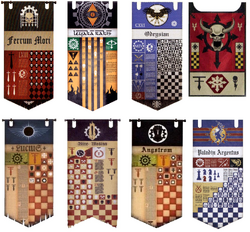
Titan honour banners of both Traitor and Loyalist Titan Legions (Top Row: Legio Mortis, Legio Fureans, Legio Tempestor and Legio Excruciatus) (Bottom Row: Legio Astorum, Legio Atarus, Legio Crucius & Legio Gryphonicus)
Like the Space Marines of the Adeptus Astartes, each Titan Legion or Titan Order has its own complex system of heraldry. These are closely tied to the Legio's history and victories, as well as their homeworld of origin, and are often the embodiment of the individual Legio's personality and collective character.
Over the Imperium's history the Titan Legions have changed their colours and patterns, but less than might be supposed. Tradition and pride run deep in every Legio. Even the colours of the ancient Legio Titanicus were kept and transferred to their successor Legios during the Horus Heresy and the subsequent Great Scouring. During the time of the Horus Heresy, the Legios and the newly forming Orders retained their colours as more than a mark of each Order, the colours became badges of loyalty to the Emperor or to Warmaster Horus.
Each Order of Titans has its own emblem and colours. For example, the colours of the Divisio Militaris Order of the Legio Ignatum are red and gold; all its Titans are painted in these two colours. Its emblem, of a wasp in a blue-bordered white triangle, is painted on the carapace of each of its Titans, and each has the banner of the Collegia Titanica's Divisio Militaris mounted on its carapace. On the lower fairing of each leg -- so as to be visible to ground troops -- is the Titan's class symbol. Each Titan has its own personal princeps honour banner or "victory banner," hanging from its "waist". This bears the badge of the Legio, and -- in the case of the Fire Wasps -- white skulls as victory symbols.
Individual crews often attach additional kill banners to the weapons of their Titans, recording the number of kills each weapon has scored. This often includes some unoffical emblem adopted by the Titan's princeps, or by the moderatus in charge of the weapons. Some Titans also have personal emblems, slogans and the like painted on their carapace, weapons or leg fairings, and in many Legios crews are permitted a great degree of freedom in personalising their Titans. The basic colours of the Legio and its badges must, of course, be retained and respected.
In the aftermath of the Horus Heresy the loyal Titan Legions of the Collegia Titanica began adding Purity Seals to their Titans. These huge seals (very similar to their smaller counterparts utilised by individual Space Marines of the Adeptus Astartes) were made of soft metal and applied by the Tech-priests of the Adeptus Mechanicus as a mark of purity and a ward against corruption.
Painted and inscribed with runes, decorated with long ribbon banners, the seals are still placed upon Titans. They are a remembrance of the shameful days of the Heresy when thousands of Titans were turned against the Emperor by the dark influence of Chaos. During the Great Scouring the Titans also carried a campaign pennant on the Divisio Militaris banner. This long white flag was added to the Titans as a mark of loyalty, and usually bore a Loyalist slogan, Perfidi Purgendi or Bellum Iustum, (translated in High Gothic as "treachery purged" and "just war," respectively) were popular examples. Such banners are rarely used today, for few campaigns have ever required such devotion and fanaticism as were needed to combat the Heresy.
The Traitor Titan Legions of the Horus Heresy maintained their old Legio's colours in most cases after the conflict: the black, white and yellow of the Fire Masters; the black and orange of the Legio Fureans and the black, white and red of the Legio Mortis. Imperial banners, however, were universally replaced by flags showing the the Eye of Horus, the mark of rebellion and fealty to the Warmaster.
Titan Crew
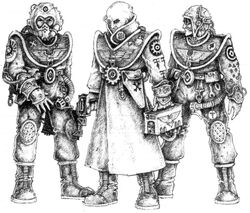
An Imperial Titan Crew; a senior princeps flanked by two moderati.
The commander of a Titan is an individual who is a member of the Adeptus Mechanicus' Collegia Titanica called the princeps, a rare individual in that they can retain their sanity after connecting with the "Machine Spirit" (computerised artificial intelligence) of the Titan through an MIU (Mind Impulse Unit) neural interface. The princeps controls the Titan by means of the mental link provided by the MIU.
Using this ancient technology, the princeps merges his or her consciousness with the Titan's sentient "Machine Spirit" -- its artificial intelligence. The Mind Impulse Unit enables this link by creating an interactive and immersive sensory space -- sometimes referred to as "the Manifold" -- in which the princeps can comprehend their war engine and their environment when they become the towering war engine.
The Titan is operated, in enforced cooperation with the Machine Spirit, through mental commands issued in the Manifold by the princeps. Such neural enmeshing is extremely taxing, and most princeps cannot bear the strain of controlling all of a Titan's systems -- and those who do, only can for short periods of time. Thus the princeps must be assisted in operating the war machine by junior officers called moderati, whose purpose is to operate some of the Titan's systems in their commander's stead.
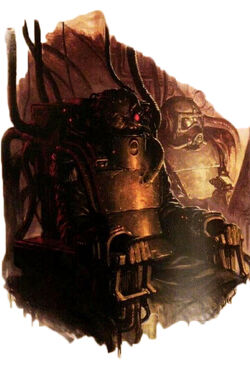
A high princeps of the Legio Astorum on the command bridge of his Reaver-class Titan.
To establish the link between the Machine Spirit and the Human mind requires that the princeps submit to extensive cybernetic augmentation of his or her central nervous system, either by accepting the implantation of several cybernetic implants at the back of the neck and skull, a series of implants in the spine which enable the linking of the MIU to the spinal cord or even undergoing entombment in an amniotic tank with large parts of the body rewired to accomodate cybernetic interaction with the Titan. Additionally, some Titan Legions utilise auxiliary haptic connectors, though others discard such measures as too delicate and too easily compromised to be placed in a war engine.
As mentioned, some Titan princeps are interred within an amniotic tank, a device filled with a jelly-like polycarbon fluid in which the individual is suspended, and equipped with augmitters and vox-casters which allow the person within to communicate with their surroundings. The device acts as a complete life support unit, handling all of the vital bodily functions of the princeps within. The fluid's function is to suspend the individual within the casket, greatly lessening the strain on their nervous system, and to create a stable neurochemical environment. Most usually, it is also a carrier of nutrients and oxygen, and in such a case the Human within is modified to breathe it through his or her lungs.
Sometimes, however, the fluid does not fulfill this function, and in this case the life support unit will provide external blood oxygenation and removal of excess carbon dioxide, which is then once again supplied into the body and into the right atrium. To facilitate such a change, the princeps' heart will possess an artificially created foramen ovale -- a hole between the upper chambers of the heart, allowing the blood flowing into the right atrium to bypass the lungs -- which perform no function while in the tank -- and enter the left atrium, from where it flows into the left ventricle and is further distributed across the body. Such an artificial circulatory system, as well as the body's suspension in amniotic fluids, closely resembles that of a gestating foetus within its mother's womb.
Due to their near-complete uselessness, the hands and feet of a princeps interred in an amniotic tank are sometimes amputated and replaced with augmetic haptic sheaths that serve as a part of the broader Mind Impulse Unit. In addition, the eyes are occasionally removed, and the sense of sight, along with others, is replaced by the sensors and auspexes of the Titan and those built into the amniotic casket. Eye sockets then serve as another medium of connection for the individual to the Mind Impulse Unit, possibly making use of the conveniently placed ocular nerves. The cybernetic link created via an amniotic interface is much deeper than that attained using hard-plugs, which makes disconnection from the MIU much harder. It is a complex ritual that can only be performed by a senior Tech-priest, and if not carried out appropriately the princeps in question can suffer severe mental and neural trauma.
Internment in an amniotic tank allows the princeps within to enmesh with the Titan's Machine Spirit more completely than they would ever be able to utilising only hard-plug connection. This greater and even more immersive connection grants an advantage in comprehension of the war engine and speed of reaction over a princeps using the more traditional connection methods. A princeps utilising amniotic interfacing is also at all times in remote communion with their war engine, even when the Mind Impulse Unit is deactivated and the Titan itself is shut down.
Because of this permanent neural connection, these princeps suffer none of the symptoms of withdrawal or the pain of separation which are the domain of pilots using standard hard-plug connection. However, due to this constant mindlink, and because of the atrophied state of their bodies, they are more exposed to the Mind Impulse Unit's effects on the psyche. This is only natural, for as the body atrophies and grows weaker from lack of use, the mind further withdraws into the depths of the Manifold and the personality is degraded. The Human within slowly but surely is detached from their Humanity, and eventually becomes nothing more than a dysfunctional part of the machine, their consciousness lost in the artificial mental landscape created by the Mind Impulse Unit.
For this reason, many princeps hesitate to embrace amniotic immersion despite its advantages and fear the consequences it would bring, while some other members of a Titan's crew view such individuals with a measure of unease and uncertainty. Still, amniotic interfacing offers considerable advantages, and for this reason its use is standard practice in some Titan Legions, and some patterns of Titans require it by design.
Princeps will also be modified for internment in an amniotic tank in order to save their lives, for example after they sustain great physical or mental trauma, as often occurs after surviving the destruction of a Titan, or when their addiction to the link grows severe enough that they may not be able to bear disconnection from the MIU. Amniotic immersion is then used to preserve their ruined bodies and to keep their sanity intact through the permanent connection to the Mind Impulse Unit it allows.
When the princeps is linked to a Titan's MIU, they feel the Titan's body as if it was their own -- their hands become weapon arms, their senses are turned into powerful auspexes and their skin becomes the thick adamantium hull -- an experience of supremacy and escape from Human frailty that addicts every princeps to his or her link with a Titan. The princeps is then able to command the Titan intuitively -- they merely need to think of undertaking an action and the machine complies.
During this operation, the princeps does not lose conciousness of their own body, and is able to simultaneously move and act as normal within the Titan's cockpit. It requires a strong will to maintain this connection, and Titans can go out of control on rampages of destruction should their princeps fail to maintain dominance over its sentience. Particularly ancient and war-worn Titans are known to hold neural imprints of all their previous princeps' personalities in their Machine Spirit. There has also been noted rare instances where a princeps has died while connected to the Titan, thus creating a digital "ghost" of themselves that remains inside the Titan's Machine Spirit. This is often referred to as a "ghost in the link."
The process of linking the Human mind to a god-machine is very difficult and dangerous, as a Titan is possessed of a ferociously potent Machine Spirit; one that is unlike any other, harbouring its own savage and instinctive intelligence. The princeps must break the machine's instinctive opposition to control and bind it to their will -- a feat requiring enormous willpower. Because of this, princeps are rare individuals, and one of the tasks the Collegia Titanica carries out is to discover them wherever they can be found and train them to command the colossal war engines.
Whilst normally the Adeptus Mechanicus searches for its personnel within the faithful of the Cult Mechanicus, the sheer rarity of such individuals requires the Mechanicus to search in the broader populace of the Imperium. Barely one in ten million possess the necessary qualifications and mental abilities to serve as a princeps, and even fewer of this number make it through the training to finally command a war engine. Because of this reality, princeps are immensely valuable individuals, and their home Forge World will spare no effort to recover them should they go missing in action, and if the slimmest chance exists that they are still alive. There are two ways in which one can become a princeps -- undergoing training in Collegia Titanica academies, as mentioned above, or advancing from the rank of a moderatus to a full princepture, which is usually the command of a Warhound-class Scout Titan.
There is also a perverse effect to the mind-link: it is highly addictive to the Human mind. From the moment they manage to dominate their Titan's Machine Spirit, the princeps will actively crave being linked to his war engine, for the feeling of becoming a godlike machine of destruction is impossibly intense, and living as a mere Human eventually becomes intolerable for some princeps. Alas, this withdrawal also accelerates the princeps' descent into madness, straining their mind when they are not linked to their mighty war machine. If a princeps does not fall in battle, they will ultimately fall to the Machine Spirit of their Titan when their will finally snaps.
Being linked to the Titan's Mind Impulse Unit is a considerable effort in itself, and controlling the war machine's systems precisely is difficult. Most Princeps are incapable of controlling all of a Titan's functions simultaneously due to the sheer, unbearable mental tumult it inflicts, and those who do will only do so for short periods of time. For this reason, princeps are assisted in operating these towering war machines by junior officers called moderati -- whose role is to operate some of the Titan's systems in their commander's stead -- lessening the mental strain placed on the princeps and allowing for the efficient handling of the machine.
The mind-link is a very intimate and immersive connection, causing the princeps and the Titan to leave an imprint in each other's consciousness and grow increasingly alike over time. The Titan's Machine Spirit will learn from its princeps and from the battles they take part in, storing the knowledge and making it available at all times and to any princeps that will command the war machine in the future. The princeps on the other hand, will, with time, begin to show traits of character akin to those of his or her war engine.
The nature of the Machine Spirits varies between individual Titans, however war engines of the same class will be similar. Thus, the commanders of Warhound-class Scout Titans are known to be bellicose and belligerent, and sometimes loners, though the latter may be due to their generally solitary assignments as scouts, while the princeps of other war engines are more cool-headed and better capable of cooperation as part of a larger force.
The princeps is seated on a command throne in the Titan's head, along with their moderati several system controllers and second-line bridge officers who act as the Titan's command crew. Lower-ranking officers called "steersmen" who are not in line to ever become princeps often control the Titan's most basic functions like locomotion. The number of moderati and steersmen depends on the size of the Titan, and their duties involve secondary tasks like regulating and maintaining the massive walker's weapons and other systems, as well as monitoring and interpreting readings from the Titan's auspexes (complex arrays of various types of sensors). All Titan officers who are expected to serve as princeps begin their career at the Collegiate Titanica on Mars where they are trained in how to pilot and interact with a Titan as well as many of the doctrines and rituals of the Cult Mechanicus.
Other Titan crew members include various engineers (usually Adeptus Mechanicus Tech-priests) for repair work and the necessary blessings required by the Cult Mechanicus, and servitors who are set on the more mundane tasks required by the Titan like the manipulation of controls and the monitoring of the external auspex systems. Some of the largest Titans also have Adeptus Mechanicus armed forces like Skitarii or Praetorian Servitors on board in case an enemy attempts to board and take control of or destroy the Titan.
Chaos Princeps and Moderati
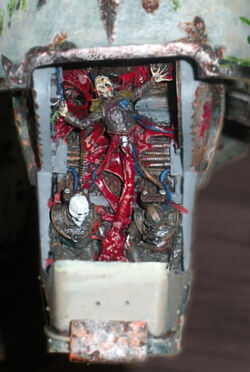
A Traitor princeps merged into one being with his war machine through the warping power of Chaos.
During the Horus Heresy, approximately half of the Titan Legions declared support for the Warmaster Horus alongside the Dark Mechanicum, and since those ancient times, the fickle blessings of the Ruinous Powers have warped many of them.
Although some of the Traitor princeps and moderati have remained largely unchanged, and are presumed to operate their machines as described above, the rest have become hideously disfigured and physically merged with the corrupted war machines they command, linking with them not only in mind, but in flesh as well.
Chaos Titans
During the Horus Heresy, approximately half of the forces of the ancient Mechanicum, including several hundred Titan Legions, turned to the service of the Warmaster Horus and eventually to the worship of Chaos, taking their mighty war machines with them as they became part of what was later called the Dark Mechanicum by the Loyalists. Chaos Titans are usually similar to their Imperial counterparts, but their long exposure to the warping influence of the energies of Chaos has changed many of them. In some cases, the crew has physically merged with their machine, making it impossible to tell where one ends and the other begins. Other crews have given themselves and their weapons over solely to one of the four great Ruinous Powers of Chaos.
The most infamous of these monster war machines was the Imperator-class Emperor Titan Dies Irae (literally "Day of Wrath" in High Gothic) which stormed the battlements of the Imperial Palace during the Siege of Terra. It was eventually destroyed 10,000 standard years later, during an Iron Warriors campaign against the Imperial world of Hydra Cordatus, where the Dies Irae engaged in battle with an entire demi-legion of twelve Imperial Titans, destroying almost all of them before finally being stopped by the Warlord-class Titan Honoris Causa.
Notable Chaos Titan Classes
Slaanesh Chaos Titans
Like their Imperial counterparts, Chaos Scout Titans dedicated to the Pleasure God Slaanesh possess incredible speed, which allows them to start attacking the enemy while the rest of the army is still charging into range. As they skirt around the foe, the Slaaneshi Scout Titans flicker with power, tapping raw energy from the Immaterium to maintain their essence within the physical realm.
Inside the hardened carapace of each of these fell god-engines is the spirit of a bound Daemon, guiding it with sheer force of will, firing its weapons as one might raise a finger. Like their smaller Daemon Knight counterparts, Slaanesh Titans do not utilise Ion Shields. Instead, they are surrounded by a glittering wall of energy created by the Warp-interface within them which anchors the Daemonic spirit inside in the material realm. This shifting, swirling aura is called the Glamour of Slaanesh and makes a Slaanesh Titan very hard to target accurately. In effect, it works like an Aeldari Holo-field, and is a yet another emulation of that xenos race's Titans.
Like a Holo-field, the Glamour of Slaanesh proves useless against barrages and other attacks spread over a wide area, as such weapons do not rely on pinpoint accuracy. Additionally, since the Glamour of Slaanesh is an interface with the Immaterium, it also provides a measure of protection against attacks drawing upon the energies of the Warp, such as Vortex Missiles or psychic powers.
Detailed below, are two known variants of Chaos Titans dedicated to Slaanesh:
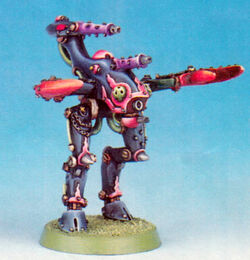
A Subjugator Scout Titan
- Subjugator Titan - When the hordes of Slaanesh attack, it is the Subjugator Scout Titans which race ahead of the army. Similar to an Imperial Warhound-class Titan, the role of these swift war machines is to suppress enemy fire and allow the Slaanesh forces to attack with minimal resistance. The Subjugator carries a strange array of weaponry, the most potent of which are the Psi-Pulse generators. These are studded with gems and enclose a honeycomb of membranes which resonate to the power of the Warp. The Subjugator uses its own link to the Warp to channel raw psychic power through the generators, creating a psi-pulse capable of punching through the thickest armour. Loping along the flanks of the battlefield, the Subjugator uses its psi-pulse to pick off enemy artillery before it can fire. The Subjugator also has two vicious Hell Claws, which it uses to rip armour to shreds and punch through the tough shells of enemy Titans.
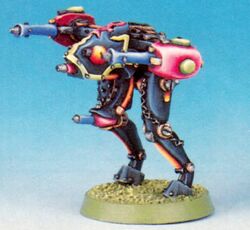
A Questor Scout Titan
- Questor Scout Titan - The Questor Scout Titan is similar to its Subjugator counterpart, only with slightly thicker armour, but its powerful legs can still drive it forward at a considerable pace. Graceful arms spread from the Questor's carapace, each tipped with a rapid-firing cannon called a Tormentor. As well as the Tormentor, the Questor also carries two power Lascannon, one mounted in the head and the other slung between the legs. Without warning the Scout Titans of Slaanesh attack, the air crackling with power and echoing to their hideous hunting cries. Protected by the coruscating Glamour of Slaanesh, these deadly war machines race into the fray with long, graceful strides. In the brief and bloody conflict that inevitably ensues, their daemonic weapons unleash a hail of death and destruction which throws the enemy into confusion. Then, as suddenly as they appear, the war machines of Slaanesh are gone, only to attack again from another point on the battlefield. Almost impossible to pin down, these deadly engines of war have broken many foes of the Lord of Pleasure with their hit-and-run tactics.
Feral Titan
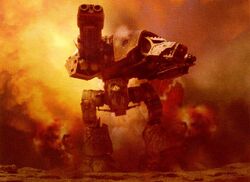
Feral-class Chaos Warhound Titan
Feral-class Titans are twisted versions of the Imperial Warhound-class Titan and are used for the same tactical purposes by the Forces of Chaos. To their eternal shame, the Titan Legions bear the stain of disloyalty to the Emperor like so many other branches of the Imperial armed forces. Like the Legiones Astartes, many of the Titan Legions also sided with Horus against the Emperor during the dark days of the Horus Heresy, and eventually fled to the dark refuge known as the Eye of Terror when their master was defeated. Within the Forces of Chaos, the dreaded Chaotic Warhound-class Titans, reclassified as Feral-class Titans by the Imperium, have seen millennia of service in the Traitor Titan Legions' pursuit of the Long War against the Imperium of Man, becoming utterly corrupted by the daemonic powers of the Warp and the fickle favour granted to these vile war machines by the Ruinous Powers. Many of these dreaded war machines easily date back to long before the Horus Heresy and have had their Machine Spirits wholly corrupted and possessed by the Warp-touched powers of Chaos. The Titan's Machine Spirit and its damned crew become possessed by daemons and are doomed to serve the will of the Chaos Gods in battle for all eternity.
Ravager Titan
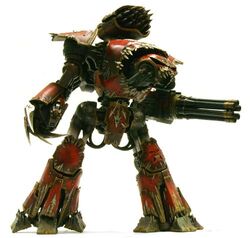
Chaos Reaver-class Battle Titan, also known as the Ravager-class after its corruption by Chaos
Ravager-class Titans are the Chaos versions of the Imperial Reaver-class Titan. Within the Forces of Chaos, the Reaver-class Titans are ancient and irreplaceable relics left over from the days of the Horus Heresy. To differentiate these corrupted Reavers from their Imperial counterparts, the Imperium has redesignated these war engines Ravager-class Titans, though this name is rarely used. They are the remnants of those Traitor Titan Legions who sided with the renegade Warmaster Horus during those dark times and whose blasphemous names still echo with dread thousands of Terran years later. The majority of these monstrous war engines have seen millennia of service with the Chaos forces and have long since become utterly corrupted by the touch of the Ruinous Powers and the Warp. Others are salvaged Imperial war engines taken from the battlefield as spoils of war, much to the eternal shame of their former masters. These captured Battle Titans have been subjected to bloody rituals in order to consecrate them to the service of the Chaos Gods. Over time, Chaos Reaver Battle Titans become an amalgam of daemon and machine, their once living crews fused to the controls and their souls subsumed into the Titan's tainted Machine Spirit, the war machine itself now a single being dedicated to destruction and butchery, reborn to spend an eternity of battle in servitude to Chaos. Revered and tended to by the Warp-tainted Hereteks of the Dark Mechanicus, lesser servants of the damned view these towering engines of destruction as incarnate gods of fire and death. Many of the lesser beings who serve Chaos make obeisance to them, offering sacrifices of captives and even their own lives to slake these towering monsters' thirst for blood.
Chaos Warlord Titans

A Chaos-corrupted Warlord-class Titan
Amongst the Forces of Chaos, Warlord-class Chaos Titans are ancient and irreplaceable relics left over from the days of the Horus Heresy. They are the remnants of those Traitor Titan Legions who sided with the Renegade Warmaster Horus during those dark times and whose blasphemous names still echo with dread thousands of Terran years later.
The majority of these monstrous war engines have seen millennia of service with the forces of Chaos and have long since become utterly corrupted by the touch of the Ruinous Powers and the Warp. To differentiate these corrupted Warlords from their Imperial counterparts, the Imperium has designated these war machines with different class names that have been happily adopted by these Titans' Renegade crews.
The Chaos Warlord-class Titan has 4 different variants depending on which Ruinous Power of Chaos the Titan is aligned with. Even though there are different versions of the Chaos-altered Warlord-class Titan, the most commonly seen variant operating with the Forces of Chaos is the Banelord Titan.
- Banelord-class Titan - The Banelord-class Titan is dedicated to the Chaos Blood God Khorne and has been modified with a long tail that ends in a large cannon of various types, while another such cannon protrudes from the Titan's daemonic mouth. The Banelord also has access to three special weapons: a Havoc Missile Rack, a Hellstrike Cannon and a Doomfist. This is the most common Chaos Warlord Titan.
- Plaguelord-class Titan - The Plaguelord-class Titan is dedicated to the Chaos Plague God Nurgle.
- Painlord-class Titan - The Painlord-class Titan is dedicated to the Chaos Pleasure God Slaanesh.
- Warplord-class Titan - The Warplord-class Titan is dedicated to the Chaos Lord of Change Tzeentch.
Chaos Emperor Titans
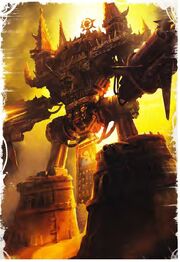
The infamous Imperator-class Titan Dies Irae of the Legio Mortis during the Horus Heresy
Imperator-class and Warmonger-class Emperor Titans are the greatest war engines ever created by the Imperium of Man. Those few Emperor-grade Battle Titans to fall into the hands of the Traitor Legions during the Horus Heresy that still exist today are rarely deployed on the battlefield and only when the Forces of Chaos have decided that they are willing to pay any cost to secure a victory. Most Chaos Emperor Titans have been possessed by Greater Daemons which have transformed these great war engines into towering leviathans of Warp-corrupted steel and Adamantium, a true incarnation of the power of Chaos in the material realm.
Notable Emperor-Class Titans
- Abominatus "Despoiler of Worlds" (Imperator-class Titan) - Abominatus is one of the most terrifying of all the servants of the Blood God. Abominatus is the hellish union of an Imperator-class Titan and a Greater Daemon of Khorne. When it walks the ground shakes beneath its steel shod feet and the enemies of the Blood God quail in fear. This Chaos Titan wields fire and steel against its foes, with flames and gun smoke flickering from each casement and embrasure in its massive body, its soul burns with the unquenchable fire of a Daemon's hate. Abominatus carries a veritable arsenal of weapons built onto its body. Its main armament, the Hellstorm Cannon and Plasma Annihilator, along with its main battery function in an identical fashion to its Imperial counterpart. However the weapons on its main fighting platform are quite different. This Chaos-possessed Titan also has a Scorpion Cannon, a lethal multi-barrelled weapon used for close assaults and is normally mounted on Daemon Engines of Khorne. It possesses Manglers, huge battle claws which can sweep aside battle tanks and flay enemy Titans to twisted metal. As Abominatus is part daemon and part machine, this makes it particularly resistant to psychic attack as well.
- Augmenautus Rex - The Chaos Imperator-class Titan Augmenautus Rex fought against the Legio Invicta and the Legio Tempestus forces defending the Forge World of Orestes in 779.M41. It vaporised the Legio Tempestus Warlord-class Titan Orestes Magnificat with a single shot. The Princeps of the Legio Invicta Warlord-class Titan Sicarian Faero, Vancent Kung, linked his MIU (Mind Impulse Unit) with those of Titans from three battlegroups to take down the Augmenautus Rex with an assault coordinated by a single mind. Such a measure, although forbidden, was required as the Imperator-class Titan's Void Shields were so potent that they would have withstood a more dispersed assault. It is said that after the Augmenautus Rex had fallen disabled, it took another ten minutes of sustained fire to destroy it.
- Bubonis - Bubonis, the Daemonic Plague Titan of Nurgle, was a special class of Chaos Imperator-class Titan that was fused with a Greater Daemon of Nurgle.
- Caligula - The Caligula is a Chaos Imperator-class Emperor Titan that is similarly aligned with the Blood God Khorne and host to one of his Greater Daemons.
- Dies Irae - The most infamous of these monster war machines was the Imperator-class Emperor Titan Dies Irae (literally "Day of Wrath" in High Gothic) which stormed the battlements of the Imperial Palace during the Battle of Terra and had been assigned to to the 63rd Expeditionary Fleet, the Warmaster Horus' own fleet, throughout the Great Crusade. It was eventually destroyed 10,000 standard years later in the 41st Millennium, during an Iron Warriors campaign against the Imperial world of Hydra Cordatus, where the Dies Irae engaged in battle with an entire demi-legion of twelve Imperial Titans, destroying almost all of them before finally being stopped by the Warlord-class Titan Honoris Causa.
- Skylok - Skylok, the Winged Titan of Tzeentch, was a unique Chaos Imperator-class Titan, which was created through its fusion with a Greater Daemon of Tzeentch.
Ork Gargants

The Ork equivalent of a Titan is called a Gargant. Gargants are as much idols of the savage Ork Gods, Gork and Mork, as they are engines of destruction. Big Mek Orks receive a divine vision of sorts from Gork (or possibly Mork), and set out to bring that vision to life in the artistic medium of thick armour plates, smoke-belching engines, and lots and lots of very large guns. This quickly spreads amongst other Big Meks in the area, and soon Gargants spring up all over the place. The construction of Gargants is one of the typical signs of an impending WAAAGH! from an Ork-held system.
In an Ork warband, there can exist Gargants and Gargant-like mecha war machines all the way from one-Gretchin (small, greenskinned goblinoid creatures closely related to Orks) Killa Kans which are the Ork equivalent of the Space Marine Dreadnoughts to the vast armoured behemoths of the Mega-Gargants. From smallest to largest, the most typical machines of these type include:
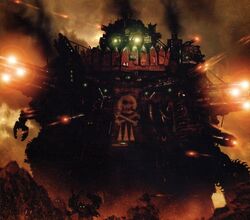
Stompas
Stompas are neither war engines nor Titans proper but rather large, armoured fighting vehicles built as roughly Ork-shaped effigies. They are armed with both long- and short-range weaponry and are used in the same manner as heavy tanks. Supa-Stompas are significantly more powerful than regular Stompas, and count as war engines. They can mount two of the weapons that are carried on the larger Gargants and can be seen as equivalent in firepower to a Warhound-class Scout Titan of the Imperium.
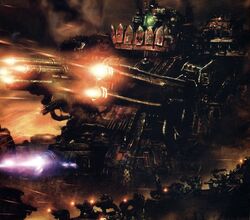
Gargants
Gargants and Great Gargants are Ork Titans and are the equivalent of an Imperial Titan. Gargants are massive constructions that are broad and squat compared to an Imperial Titan. Gargants are as much idols of the savage Ork Gods, Gork and Mork, as they are engines of destruction.
Big Mek Orks receive a divine vision of sorts from Gork (or possibly Mork), and set out to bring that vision to life in the artistic medium of thick armour plates, smoke-belching engines, and lots and lots of very, very large guns. This activity quickly spreads amongst other Big Meks in the local Ork-settled area who seek to compete in Gargant-building, and soon Gargants spring up all over the place.
The construction of Gargants is one of the typical signs of an impending WAAAGH! from an Ork-held star system. In an Ork army, there can exist Gargants and Gargant-like war machines from Killa Kans (which are the Ork equivalent of the Space Marine Dreadnoughts) crewed by a single Gretchin to the vast armoured behemoths that are the Mega-Gargants.
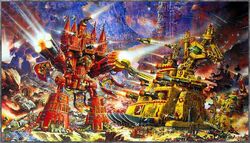
Imperator-class Titan faces off against an Ork Mega-Gargant
Mega-Gargant
The Mega-Gargant is a very rare, super-large Gargant on a par in size with the Imperator and Warmonger-class Emperor Titans, though not as powerful.
It carries a large number and variety of weapons including the Mega-Dropper. Unlike the other Gargants which shuffle forward on their short mechanical legs, the Mega-Gargant is actually a tracked vehicle; essentially it is a mobile Ork fortress.
Big Mek Stompas/Gargants
Often a Big Mek Ork will not be satisfied with the production of Battlewagons, and will create his own Stompa or Gargant. These Titan-like monstrosities mount the latest Mek weaponry, such as the 'Lifta-droppa'. The size of the Stompa or Gargant depends on how much influence the Mek has, how much raw materials there are, and who they are "constructing" it with.
Occasionally, two Meks may work together, combining their love of tinkering to produce a new Gargant on their own initiative or because they have been commanded to do so by a larger, tougher Ork Warboss or Warlord.
Construction
Ork Gargants are an extremely varied lot, with no two ever being exactly alike, as is common with seemingly slapdash Ork technology. Thanks to the frenzied imaginations of the Mekboyz building them, Ork weapons tend to be haphazard, unreliable and noisy. When they work, however, they can inflict gruesome damage. Gargants are commonly equipped with at least one close-combat weapon, because charging in and bashing heads is considered to be a very "Orky" thing to do.
For defence, Gargants have Power Fields which are the Ork equivalent of an Imperial Titan's Void Shields; however, while Gargants tend to have more intense and reflective Power Fields that an Imperial Titan, they cannot regenerate these during the battle like a Titan is able to do.
Orks do not rely on auto-systems to the same extent as the other intelligent races, and Gargants carry a large crew of both Orks and Gretchins. The crew is led by a Kaptin, who relays orders through a body of officers. A speaking-tube is the preferred method of communication within a Gargant. Each officer is in charge of one section of the Gargant, be it a weapon, the magazine, the engine room, or any other chambers. Under the officer is a crew of Orks and Gretchins who carry out the orders passed down to them. Repair crews are composed of Gretchins, whose smaller build suits them for crawling through cramped spaces armed with wrenches and oily rags.
Compared to Imperial Titans, Ork Gargants have weaker armour and comparatively shorter-ranged weaponry. Nevertheless, Gargants are extremely difficult to destroy due to their dense (albeit crude) construction (in games, this is represented by Gargants having more structure points). While Gargants do not suffer from potentially fatal plasma reactor meltdowns, they are particularly vulnerable to fires and magazine explosions.
Aeldari Titans
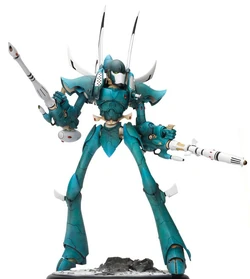
An Aeldari Phantom Titan looming over the battlefield.
Aeldari Titans are quick and nimble machines of war. They are thinly armoured but despite their frailty, Aeldari Titans can pack a mean offensive punch, and can move about the battlefield with frightening speed, thanks to their Jump Jets.
Instead of the Void Shields used by other intelligent races' Titans, the Aeldari rely upon advanced holographic field generators which in conjunction with speed make their Titans extremely difficult to target. However, holo-fields do not actually deflect enemy firepower, so Aeldari Titans are even more vulnerable should they suffer hits.
Aeldari Titans are also unlike those of other starfaring species in that they are powered by the actual spirits of individual Craftworld Asuryani contained in a core of psycho-reactive material called wraithbone, which is a material also used in the construction of the Titan's carapace due to its light weight and great durability.
The pilots of the machines link psychically with the Aeldari spirits in their core, rather like the princeps of an Imperial Titan linking to its artificial intelligence Machine Spirit; and this allows the Aeldari pilot to control the Titan like an extension of his own body. The Aeldari spirits, however, enhance the skills of the pilot as well as the piloting Aeldari's already superhuman reflexes and reaction times.
There are three types of Aeldari Titans:
- Revenant - The Revenant is a relatively light war machine, roughly equivalent to an Imperial Warhound, though much more agile. They are best suited for lightning-fast raids on enemy lines, using their speed to retreat before a counter-offensive can be mounted. A model of this Titan has been created by Forge World. It can come armed with either Pulsars or Sonic Lances. Like Imperial Warhound Titans, Aedari Revenant Titans are often deployed in pairs. The pilots of these pairs are usually siblings, their blood ties psychically linking them together for thought-speed communication during combat.
- Phantom - The Phantom is a more massive Aeldari war machine capable of taking on its Imperial equivalents. What makes Phantom Titans distinctive from those of lesser races is their crew. In addition to the living, the souls and memories of ancient Aeldari warriors are maintained in the wraithbone matrix of the Titan.
- Warlock - The Warlock is a refinement of the Phantom. Its wraithbone core hosts the spirits of late Asuryani Seers and Warlocks, focusing their psychic power into a near-unstoppable engine of destruction.
Tyranid Bio-Titans
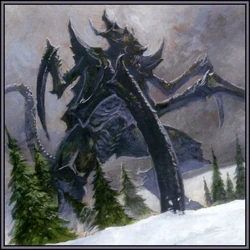
A Tyranid Bio-Titan leads the attack in an irresistible onslaught.
Bio-Titans are more than exceptionally large Tyranid bioforms, they are on a par with the Titans deployed by the other intelligent races and were created by the Tyranid Hive Fleets to directly compete with the similar massive war engines they encountered amongst the other races of the Milky Way Galaxy. Bio-Titans are deployed in the final stages of the assimilation of a planet into a Tyranid Hive Fleet's biomass.
While their supersized biomechanical weaponry is potent, Bio-Titans are feared mainly for their extreme effectiveness in close combat against enemy Titans and other war engines. They are also considerably faster than Titans of other races; as a result Bio-Titans often charge towards the enemy. Their ripper tentacles can neutralize enemy Titan close combat weapons, while monstrous claws will make short work of Titan hulls.
Bio-Titans do not generate void shields like those of the Imperial Titans or Ork Gargants; however they made up for this by being able to "regenerate" or self-heal. Bio-Titans can generate bio-plasma fields to make them less vulnerable to sniping from Imperial Volcano Cannons, though this ability was present in early Bio-Titans produced by the Tyranids but newer iterations of Bio-Titans recently encountered by Imperial forces do not seem to possess this ability.
Examples of Tyranid Bio-Titans include the Vituperator, the terrifying Hierophant and the even more monstrous Hydraphant. They are roughly equivalent to the Imperial Warhound, Reaver, and Warlord Titans, respectively.
Regular Tyranid bioforms (not war engines, let alone Titans) include the tank-sized burrowing Trygon and the winged Harridan (a Tyranid war engine that is not considered a Titan). The Hierodule was used as the name of the smaller Bio-Titan (the Hierophant was the larger Titan) when the model range was released in November 1997, however the Hierodule is now just another bioform construction.
A specialist breed of Bio-Titan is the Dominatrix, a powerful synapse creature that can use its malign intellect to command the hordes of lesser bioforms around itself with ghastly efficiency. In the hierarchy of Tyranids, they are the supreme commanders of the battlefield and second only to the shipbound Tyranid Norn-Queens themselves.
Videos
See Also
- Collegia Titanica
- Chaos Titan
- Titan Legions (List)
- Titan Weapons
- Traitor Titan Legions
- Imperial Knight
Sources
- Adeptus Titanicus (1st Edition), pp. 6, 16
- Adeptus Titanicus - The Horus Heresy: Loyalist Legios (Specialty Game), pp. 110, 158
- Adeptus Titanicus - Horus Heresy: Traitor Legios (Specialty Game), pp. 10-11, 23, 80, 110, 166-167
- Citadel Journal 9, "Legions of Chaos: Bubonis, Daemonic Plague Titan of Nurgle" by James Funnell, pp. 4-11
- Citadel Journal 10, "Skylok, Winged Titan of Tzeentch", pp. 31-37
- Citadel Journal 13, "Abominatus, Despoiler of Worlds Chaos Titan", pp. 41-44
- Citadel Miniatures Catalogue, Section Four, "Chaos Titan" by Dave Andrews
- Codex: Eye of Terror, pg. 16
- Dark Heresy: The Black Sepulchre (RPG) pg. 45
- Imperial Armour Apocalypse, pg. 104
- Imperial Armour Apocalypse 2, pg. 79
- Imperial Armour Update (2006)
- Imperial Armour Volume Six - The Siege of Vraks - Part Two, pp. 11, 13, 23, 26-27, 34-35, 42-43, 48, 78-79, 83-84, 163, 182
- Imperial Armour Volume Seven - The Siege of Vraks - Part Three, pp. 51, 88, 161
- The Beast Must Die (Novel) by Gav Thorpe, Chs. 9, 16
- The Grey Knights Omnibus (Novel) by Ben Counter, "Dark Adeptus, Ch. 7
- The Horus Heresy - Book One: Betrayal (Forge World Series) by Alan Bligh, pp. 138-141
- The Horus Heresy - Book Two: Massacre (Forge World Series) by Alan Bligh, pp. 156-159
- The Horus Heresy - Book Three: Extermination (Forge World Series) by Alan Bligh, pp. 28-30, 154-159
- The Horus Heresy - Book Four: Conquest (Forge World Series) by Alan Bligh, pp. 138-143
- The Horus Heresy - Book Five: Tempest (Forge World Series) by Alan Bligh, pp. 118, 258
- The Horus Heresy - Book Nine: Crusade (Forge World Series), pg. 138
- The Horus Heresy: Collected Visions by Alan Merett, pp. 354-362
- Titan Legions: Rulebook (1st Edition) pg. 40-50
- Titan Legions (2nd Edition), pp. 8, 11-16, 39
- Titandeath (Novel) by Guy Haley, Chs. 14, 20
- Warhammer 40,000: Apocalypse (4th Edition)
- Warhammer 40,000: Rulebook (5th Edition), pg. 121
- White Dwarf 108 (UK), "'Eavy Metal - Battle Colours from Adeptus Titanicus," by John Blanche, pp. 72-76
- White Dwarf 133 (US), "Space Marine - New Warlord Titan Weapons & Equipment," by Andy Chambers, Roger Gerrish & Karl Tebbutt, pp. 47-52
- White Dwarf 142 (US), "Titan Weapons - Imperial Titan Weapons: Chaos Energy Whip, Chaos Titan Tails", pp. 48-51
- White Dwarf 164 (US), "The Banelord: Chaos Titan of Khorne", pp. 21-25
- White Dwarf 171 (US), "Chaos Armies: Chaos Titans", pp. 32-33
- White Dwarf 178 (US), "The Titan Legions: History", pp. 45-52
- White Dwarf 180 (US), "Fists of Death: Titans Tactics", pp. 27-36
- White Dwarf 181 (US), "Epic Titan Legions - Imperator," by Gavin Thorpe, pp. 23-30
- White Dwarf 194 (US), "Modelling Workshop: Abominatus, Despoiler of Worlds", pp. 39-43
- White Dwarf 267 (US), "A Clash of Titans: A battle report - Chaos vs Ulthwé Eldar"
- White Dwarf 462 (March 2021), "Slayer of Gods", pg. 126
- Horus Rising (Novel) by Dan Abnett
- False Gods by Graham McNeill
- Galaxy In Flames (Novel) by Ben Counter
- Fulgrim (Novel) by Graham McNeill
- Mechanicum (Novel) by Graham McNeill
- Age of Darkness (Anthology), "The Iron Within" by Rob Sanders
- Storm of Iron (Novel) by Graham McNeill
- Titanicus (Novel) by Dan Abnett
- Brotherhood of the Storm (Novella) by Chris Wraight
- Warhammer Community: God-Machines and Angels - New From Forge World (30 Nov 2018)
- Warhammer Community: A New Class of Titan - Forge World Review (26 Nov 2018)
- Warhammer Community: Breaking New from the Vigilus Open Day! - The Warbringer (24 Nov 2018)
- Warhammer Community - Wisdom of the Grand Master (Titan Image)
- Warhammer Community - Warhammer Preview Online: The Dead and The Divine
- Warhammer Community - You thought the Warlord was big? Try the Warmaster Titan.
- Warhammer - Introducing the Warmaster Titan
- Warhammer Community - Meet the Warmaster Iconoclast Titan Whose Chainsword Is as Big as a Building
- Warhammer Community - When Warhounds Won't Cut It, It's the All-New, All-Smashing Dire Wolf Heavy Scout Titan (24 Jan 2022)
- Forge World Online Store - Dire Wolf Heavy Scout Titan with Neutron Laster
- Forge World Online Store - Dire Wolf Heavy Scout Titan with Volcano Cannon
| Titans | |
|---|---|
| Scout Titans | Rapier-class Titan • Warhound-class Titan (Wolf-class Titan • Mastiff-class Titan • Jackal-class Titan) |
| Heavy Scout Titans | Dire Wolf-class Titan |
| Battle Titans | Reaver-class Titan • Carnivore-class Titan • Mirage-class Titan • Komodo-class Titan • Executor-class Titan • Warbringer Nemesis-class Titan • Punisher-class Titan • Warlord-class Titan (Death Bringer-class Titan • Eclipse-class Titan • Nightgaunt-class Titan • Nemesis-class Titan • Warlord-Sinister-class Psi-Titan) • Siege Titan • Apocalypse-class Titan |
| Heavy Battle Titans | Warmaster-class Titan (Warmaster Iconoclast-class Titan) |
| Emperor Titans | Imperator-class Titan • Warmonger-class Titan |
| Chaos Titans | Subjugator Scout Titan • Questor Scout Titan • Feral-class Titan • Ravager-class Titan • Banelord-class Titan • Plaguelord-class Titan • Painlord-class Titan • Warplord-class Titan |
| STC Titan | Castigator-class Titan |


